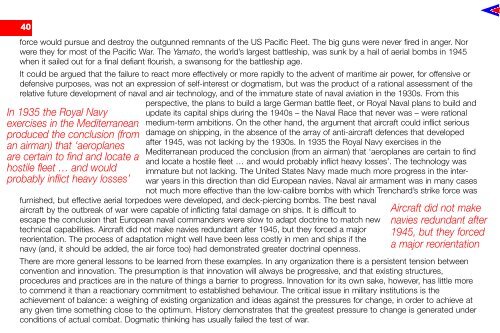THE RAF AIR POWER REVIEW - Royal Air Force Centre for Air ...
THE RAF AIR POWER REVIEW - Royal Air Force Centre for Air ...
THE RAF AIR POWER REVIEW - Royal Air Force Centre for Air ...
You also want an ePaper? Increase the reach of your titles
YUMPU automatically turns print PDFs into web optimized ePapers that Google loves.
40<br />
<strong>for</strong>ce would pursue and destroy the outgunned remnants of the US Pacific Fleet. The big guns were never fired in anger. Nor<br />
were they <strong>for</strong> most of the Pacific War. The Yamato, the world’s largest battleship, was sunk by a hail of aerial bombs in 1945<br />
when it sailed out <strong>for</strong> a final defiant flourish, a swansong <strong>for</strong> the battleship age.<br />
It could be argued that the failure to react more effectively or more rapidly to the advent of maritime air power, <strong>for</strong> offensive or<br />
defensive purposes, was not an expression of self-interest or dogmatism, but was the product of a rational assessment of the<br />
relative future development of naval and air technology, and of the immature state of naval aviation in the 1930s. From this<br />
In 1935 the <strong>Royal</strong> Navy<br />
exercises in the Mediterranean<br />
produced the conclusion (from<br />
an airman) that ‘aeroplanes<br />
are certain to find and locate a<br />
hostile fleet … and would<br />
probably inflict heavy losses’<br />
perspective, the plans to build a large German battle fleet, or <strong>Royal</strong> Naval plans to build and<br />
update its capital ships during the 1940s – the Naval Race that never was – were rational<br />
medium-term ambitions. On the other hand, the argument that aircraft could inflict serious<br />
damage on shipping, in the absence of the array of anti-aircraft defences that developed<br />
after 1945, was not lacking by the 1930s. In 1935 the <strong>Royal</strong> Navy exercises in the<br />
Mediterranean produced the conclusion (from an airman) that ‘aeroplanes are certain to find<br />
and locate a hostile fleet … and would probably inflict heavy losses’. The technology was<br />
immature but not lacking. The United States Navy made much more progress in the interwar<br />
years in this direction than did European navies. Naval air armament was in many cases<br />
not much more effective than the low-calibre bombs with which Trenchard’s strike <strong>for</strong>ce was<br />
furnished, but effective aerial torpedoes were developed, and deck-piercing bombs. The best naval<br />
aircraft by the outbreak of war were capable of inflicting fatal damage on ships. It is difficult to<br />
escape the conclusion that European naval commanders were slow to adapt doctrine to match new<br />
technical capabilities. <strong>Air</strong>craft did not make navies redundant after 1945, but they <strong>for</strong>ced a major<br />
reorientation. The process of adaptation might well have been less costly in men and ships if the<br />
navy (and, it should be added, the air <strong>for</strong>ce too) had demonstrated greater doctrinal openness.<br />
<strong>Air</strong>craft did not make<br />
navies redundant after<br />
1945, but they <strong>for</strong>ced<br />
a major reorientation<br />
There are more general lessons to be learned from these examples. In any organization there is a persistent tension between<br />
convention and innovation. The presumption is that innovation will always be progressive, and that existing structures,<br />
procedures and practices are in the nature of things a barrier to progress. Innovation <strong>for</strong> its own sake, however, has little more<br />
to commend it than a reactionary commitment to established behaviour. The critical issue in military institutions is the<br />
achievement of balance: a weighing of existing organization and ideas against the pressures <strong>for</strong> change, in order to achieve at<br />
any given time something close to the optimum. History demonstrates that the greatest pressure to change is generated under<br />
conditions of actual combat. Dogmatic thinking has usually failed the test of war.

















